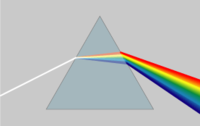
Photo from wikipedia
Knowledge on sedimentary structure within a basin is of great importance for exploring petroleum resources and predicting strong ground motions caused by earthquakes. Although 3-D seismic data acquisition is common… Click to show full abstract
Knowledge on sedimentary structure within a basin is of great importance for exploring petroleum resources and predicting strong ground motions caused by earthquakes. Although 3-D seismic data acquisition is common nowadays in petroleum industry, it is still impossible to conduct dense 3-D seismic surveys at a whole-basin scale. Passive seismic imaging thus can play a significant role in obtaining large-scale sedimentary structure of basins with a reasonably good resolution. Here we present a new method to estimate the sedimentary structure beneath a seismic station using frequency-dependent nonlinear particle motion of the teleseismic P wave, that is, a delay in the P wave arrival time on the horizontal component. Forward modeling suggests that the delay time and its variations over frequency are caused by interference of the direct P wave with the P-to-S conversions at the base of the sediments as well as sediment reverberations, and hence can be used to constrain the thickness and seismic velocity of the sediments beneath the station. We further develop a 2-D grid search technique to estimate the optimum sediment thickness (Z) and surface S wave velocity (β0) by minimizing the residuals between the observed and calculated apparent P wave splitting times. The grid search yields reasonably robust estimates of Z and β0, although it has some trade-off between the two parameters in the case of thin and unconsolidated sediments. We apply the method to 30+ broadband stations inside the Songliao basin, and the estimated sedimentary structures beneath these stations agree well with previous results.
Journal Title: Journal of Geophysical Research
Year Published: 2017
Link to full text (if available)
Share on Social Media: Sign Up to like & get
recommendations!